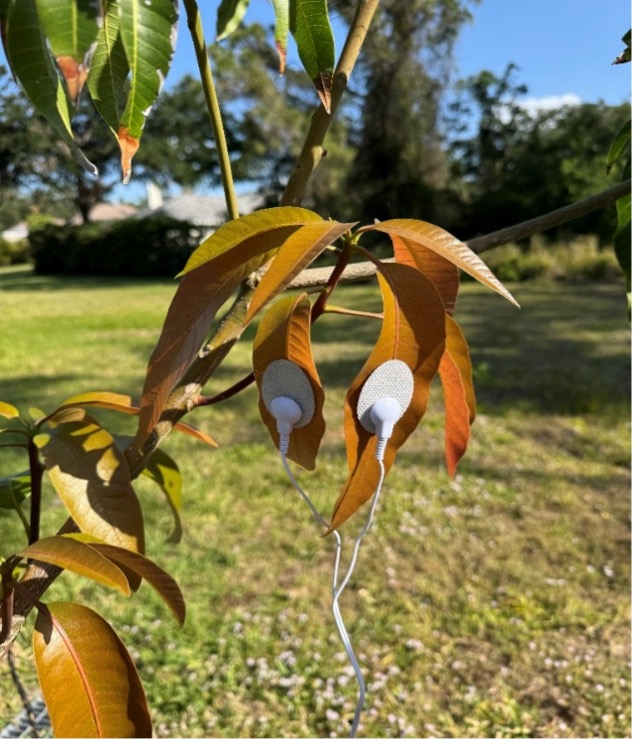Introduction
Plants are living organisms that tend to respond to changes in their environment in delicate, yet measurable ways. Plants respond to light, temperature, touch, and stress, in both physical and physiological ways similar to nerve tissues in animals. Many recent advances in technology have allowed us to explore plant activity in new and innovative ways. One such tool to explore this plant activity is PlantWave, a device that detects certain variations in electrical conductivity within a plant which then translates those fluctuations into music. The result is a captivating and unexpected way to experience plant activity and behavior in real time.
The following investigation uses this PlantWave technology to explore the various ways in which plants respond to changes in their environment through shifts in the music they produce. Although this device does not provide direct scientific data in traditional units, it provides a glimpse into what’s happening inside the plant on a physiological level.
In order to test the relationship between plant activity and environmental conditions, I have conducted three separate experiments:
- How might the amount of sunlight a plant receives cause changes in activity within a plant?
- What happens to plant activity before and after watering?
- How does cutting a small branch affect the plant’s musical output, i.e. dependent on their physiology)?
These questions are created to explore how changes in a plant’s environment are detected in the sounds produced by PlantWave technology. One ultimate goal is to utilize plant communication via PlantWave as a citizen science activity for schools and students.
Materials
- PlantWave device
- Outdoor plants – lemon, orange, and mango
- Smartphone with PlantWave app
- Watering can
- Scissors
- Notebook to record relevant observations
Experimental Procedure
- Question 1: Light Exposure
- Choose a few hours of the day prior to sunset where sunlight is prominent as well as a few hours of the day after sunset when sunlight is absent
- Choose a plant on which this experiment will be conducted
- Record music produced at each of these 6 hour intervals using one specific type of music for 2 minutes each
- Question 2: Watering
- Select any dry plant
- Record music prior to watering the plant for 2 minutes
- Gently water the plant (avoid excessively watering the plant)
- Wait 10-15 minutes and record music again for 2 minutes
- Question 3: Cutting a Branch
- Using any plant, record music for 2 minutes produced with the device attached prior to cutting a branch for 2 minutes
- Gently cut a small branch
- Proceed to record music produced at different time periods post-cut (i.e. 1 hour after cut, 2 hours after cut, etc.) for 2 minutes each
Results
In this investigation, all experiments were conducted using music recorded with the Celestial Being soundset. With this soundset, lower activity plants play only bass and electric piano, medium activity plants will add flute, and high activity plants will play electric piano faster with the addition of chimes.
Light Exposure Results:
The plant that was tested on during this experiment was the lemon plant. The times at which the music produced using PlantWave were recorded was 1:00 P.M., 2:00 P.M., 3:00 P.M, 9:00 P.M., and 10:00 P.M. From 1-3 P.M., the sun and its light was at its peak, in terms of sunlight. The music produced by the lemon plant during that time appeared to have a fast tempo and high pitch. In terms of the Celestial Being soundset, the music produced by the plant consisted of fast electrical piano notes as well as chimes. The flute can also be heard here and there during the music. This corresponds to high activity within the plant with occasional fluctuation to medium activity. There were few noticeable differences between the music produced at each of these time periods, before sunset. In contrast, the music produced by the lemon plant after sunset (9-10 P.M.) appeared to have a slower tempo and was much higher pitched. The bass was prominently heard throughout the music, and the electric piano played at a much slower rate, thus corresponding to low activity within the lemon plant after sunset. Once again, there were few differences between the music produced at each of these time periods after sunset. In summary, music produced by the lemon plant prior to sunset, where sunlight was at its peak, showed signs of higher physiological activity while music produced by the lemon plant after sunset, where sunlight was at its minimum, demonstrated lower physiological activity.
Audio Links:
Lemon Plant Audio 1pm Lemon Plant Audio 2pm Lemon Plant Audio 3pm Lemon Plant Audio 9pm Lemon Plant Audio 10pm Watering Results:
This experiment was conducted using the orange plant. It was conducted at 4:00 P.M. Using PlantWave, music was recorded for 2 minutes prior to the watering of the plant. The plant seemed to play at a more moderate tempo and fluctuated between a high and low pitch. The flute was constantly played which signified that the activity of the orange plant during this time was moderate/medium. The plant was then thoroughly watered and the music was recorded once again ten minutes after the watering of the plant. This time, after the plant was watered, the physiological activity of the plant was much higher, as one can hear the vivid chimes being played as well as the fast electric piano. At certain times, however, the music did appear to be dull with the bass solely playing indicating that there was low activity during certain periods. Overall, however, the tempo was faster and the pitch was higher. In summary, the orange plant had moderate activity prior to being watered, and once watered, activity spiked up, as detected by the music produced by the plant.
Audio Links:
Orange Plant Audio Before Watering Orange Plant Audio After Watering Branch Cutting Results:
The mango plant was used to conduct this experiment. Music was recorded from this plant prior to cutting, immediately after cutting, 1 hour after cutting, 2 hours after cutting, and 6 hours after cutting the branch of the plant. Before cutting a small branch of the mango plant, the musical output of the plant was recorded for 2 minutes. Through an analysis of the recording, I determined that the physiological activity of the plant was relatively low. Immediately after cutting the branch, the music was recorded for 2 minutes in which it can be heard that the music plays at a slightly faster rate. However, there is not much of a difference in pitch. The flute can be heard several times throughout the recording, thus leading to the conclusion that the physiological activity immediately after cutting the plant is moderate/medium. The same result is observed during the musical recording of the mango plant 1 hour after the small branch was cut. The physiological activity then seems to shift back to low 2 and 6 hours after the small branch was cut from this tree. The bass is heard more and the electric piano plays slower. To summarize, prior to cutting a small branch of the mango plant, physiological activity was low and for the first hour after cutting the branch, electrical activity slightly increased to a more moderate level. After the first hour, electric activity then shifted back to low.
Audio Links:
Mango Plant Audio Before Cutting Branch Mango Plant Audio 1 Hour After Cutting Branch Mango Plant Audio 2 Hours After Cutting Branch Mango Plant Audio 6 Hours After Cutting Branch 
Conclusion
Many scientists have made important contributions throughout history related to plant electrophysiology. For example, Michael Pollan’s influential 2013 paper, “
The Intelligent Plant,” brought widespread public attention to the field of plant neurobiology, exploring how plants may be able to perceive and interact with the environment around them in complex ways. More recently, Zoe Shlanger’s book
The Light Eaters continues to build off this idea by putting together current research that highlights the adaptive, responsive, and intellectual capacities of plants. In addition, Stefano Mancuso, a contemporary plant neurobiologist, argues for the intelligent and communicative nature of plant behavior. His work supports the view that plants process information and make decisions adaptive to this information, thus aligning with the idea that their biofeedback can be meaningful.
The results from this investigation suggest that environmental changes such as sunlight exposure, watering, and physical damage can influence the physiological activity of plants, as reflected in the music generated by PlantWave using the “Celestial Being” soundset. The lemon plant exhibited higher activity during periods of peak sunlight and noticeably lower activity after sunset, indicating a potential correlation between light levels and internal plant responsiveness. Similarly, the orange plant demonstrated a rise in activity shortly after being watered, supporting the idea that hydration plays a role in increasing physiological engagement. In the case of the mango plant, cutting a small branch led to a temporary increase in activity, possibly as a stress response, before settling back into a low-activity state within a few hours.
The reason the lemon tree exhibited higher physiological activity during periods of sunlight compared to periods of lower sunlight after sunset is photosynthesis. Photosynthesis is a process by which plants convert light energy into chemical energy, which is then harvested by the plant as food. During the daytime, where sunlight is at its peak, the lemon tree is actively undergoing photosynthesis, which likely explains the increased electrical signaling and thus the interpretation of higher physiological activity. On the other hand, at nighttime (after sunset), where sunlight is scarce, the plant goes into a more dormant state (where photosynthesis is not actively occurring), there is less activity within the plant thus correlating to lower levels of electrical signaling. In other words, the reason that may explain the differences in electrical activity between daytime and nighttime is how actively photosynthesis is occurring within the plant.
Water availability also plays a role in the physiological activity of plants, as depicted by the results. Compared to no watering, moderate watering of a plant tends to result in higher activity within the plant. The reason for this could be because of water molecules activating certain internal processes within the plant. One of these is nutrient uptake and transport. When the orange tree is watered, the sudden stream of water causes the plant to undergo nutrient uptake where it is then transported through the xylem. These processes are the reason for increased activity within the plant and higher amounts of electrical signaling.
The reason the lemon tree exhibited higher physiological activity during periods of sunlight compared to periods of lower sunlight after sunset is photosynthesis. Photosynthesis is a process by which plants convert light energy into chemical energy, which is then harvested by the plant as food. During the daytime, where sunlight is at its peak, the lemon tree is actively undergoing photosynthesis, which likely explains the increased electrical signaling and thus the interpretation of higher physiological activity. On the other hand, at nighttime (after sunset), where sunlight is scarce, the plant goes into a more dormant state (where photosynthesis is not actively occurring), there is less activity within the plant thus correlating to lower levels of electrical signaling. In other words, the reason that may explain the differences in electrical activity between daytime and nighttime is how actively photosynthesis is occurring within the plant.
Water availability also plays a role in the physiological activity of plants, as depicted by the results. Compared to no watering, moderate watering of a plant tends to result in higher activity within the plant. The reason for this could be because of water molecules activating certain internal processes within the plant. One of these is nutrient uptake and transport. When the orange tree is watered, the sudden stream of water causes the plant to undergo nutrient uptake where it is then transported through the xylem. These processes are the reason for increased activity within the plant and higher amounts of electrical signaling.
The immediate increase in electrical activity in response to cutting a branch of the mango tree likely demonstrates a brief healing response. The increased electrical activity occurred as a result of the plant’s response to the “wound”. It could redirect resources to the wounded area and activate defense mechanism. The plants eventually return to normal physiological activity as they stabilize.
Additionally, Professor Brian Pijanowski’s citizen science project
RecordTheEarth.org had gathered over 7000 environmental soundscapes contributed by users globally. However, during that time, sonification technologies that captured real-time plant biofeedback had not yet existed. Now, tools like PlantWave have made it possible to transform electrical signals from plants into sound, which allows for a more direct and interpretable way to experience plant behavior, thus marking a significant change in how we are able to engage with plant life.
The PlantWave device does not measure true plant health. Despite this, it may be a great device for citizen science, to share with schools, students and families to allow them to “monitor” their garden and plant health in a rudimentary way.







